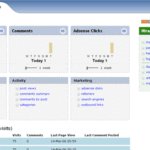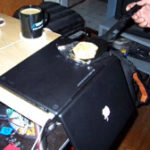Secure and out-of-the-box Server/Gateway
If your are a network or system administrator of a SME (Small to Medium Enterprise) then you’ll have to do a lot of things that go beyond the call of your duty. You need to find systems, softwares and tools, recommend them to the management, justify your recommendation and make sure everything runs smoothly. There is a never ending search for perfect systems and softwares which are of good qualities and cost as less as possible. A typical SME would need at minimum following servers in order to run their business smoothly:
- Email Server
Web Server
DNS Server
File Server
Print Server
Internet Gateway (Firewall/Router/Proxy)
There are many choices in the market and the first decision we need to make is about the platform we want to run. I mean the operating system. There are choices: Unix, Linux, Windows, MacOS and BSD. But in reality the actual contenders today are Windows and Linux. From my experience as a system and network admin for more than 6 years I can comfortably recommend you to use Linux (this is not a news for sysadmins anyway). Simply because they’re secure, do their job best and most importantly they’re free. What more to expect? Of course they don’t come with the support like windows but if you really need support you can buy them (e.g RedHat, Suse or Mitel). I think in many ways the community support for popular open source softwares are already outstanding.
So, after choosing our platform “Linux” we need to decide which Linux distribution is best suited for us. There are plenty of Linux distributions mushrooming today. You can see the popularity of different Linux distribution at Distrowatch.com based on H.P.D (Hits Per Day). The choice of distribution will differ depending on need and taste (of the admins or organizations). But here I’m recommending a Linux Distribution that does the job out-of-the-box and stands separate from the crowd in many different ways.
What is SME Server?
This is what Distrowatch.com says about SME Server :
- SME Server (known as e-smith at the time) was founded in January 1999 by Joseph and Kim Morrison. The company introduced the first version of its flagship software product, the e-smith server and gateway, in April 1999. By the end of the year, many thousands of e-smith servers were running in countries from Fiji to Finland. Word was spreading quickly among developers and systems integrators who needed a solid, easy-to-use server for their small-business customers. In July 2001, e-smith was acquired by Mitel Networks, in September 2004 by Lycoris, and the project is currently sponsored by Resource Strategies, Inc.
SME Server is based on the RedHat 7.3 (current stable version is SME Server 6.0.1) which has been customized by removing unnecessary software, and by replacing some with more secure software. SME Server uses the kernel 2.4.x.x. Currently they’re developing a newer version (SME server 7.0) based on RedHat, Fedora and CentOS.
Why SME Server?
Easy Installation. Download ISO, burn CD and after few clicks it’s installed. Takes less than 20mins to install in P4 machines. You can read the excellent documents, which are very detail. The first docs I recommend to read are Design Philosophy and Architecture Overview. This will give a clear picture on how it stands out of the crowd and the basic architectural concept you need to know to use it.
It is much more secure and maintainable than other linux distributions because unnecessary packages are removed and services stopped. It also acts as a firewall by blocking all the access from external network except for those public services that are configured.
Web based administration panel (server-manager). Basically everything can be done from the web. Some Screenshots to get the look and feel of SME server-manager.
Secure Email Server. Supports POP3, POP3 over SSL, IMAP, IMAP over SSL, SMTP, SMTP over SSL and webmail (Horde IMP). Can install Spamassassin and Clam AV to do the server side junk and virus filtering. Runs Qmail which is much secure than Sendmail. The author of Qmail (D. J. Bernstein) provides a security guarantee and offered $500 for the first person to find a verifiable security hole in latest version of Qmail in 1997, his offer still stands and nobody has found any security hole in the Qmail till today.
Web Server. Runs Apache, supports virtual domains and SSL. Also it’s a complete LAMP out of the box. I’ve written about the LAMP in my previous article Top Open Sources.
PPTP VPN Server. Can be enabled by one click which is very useful and convenient for secure remote connection.
DNS Server. Runs djbdns which is a very secure dns package written by the same author of Qmail. And also offers $500 for first person who reports a verifiable security hole.
Raid-1. Supports Raid-1 mirroring both hardware and software. I find it very useful. If one hard disk is dead, just plugin a new one and rebuilt the Raid.
Proxy Server. Runs transparent proxy on Squid. No need to configure the client browser.
File Server. Samba server can be a domain controller or participate in windows domain.
Built in Backup/Restore function. You can backup to tape (scheduled) or your desktop (now). Similarly the backed-up data can be restored with one click.
FTP Server/Print Server. These services can be easily enabled or disabled.
Plenty of other softwares that are contributed by users and developers.
If you want an out-of-the-box solution for basic services (email, web, file, print, gateway) then it’s the best choice available. If you want a secure and easy to install/use/maintain distribution then you should definitely give SME Server one shot.






Wow, I’ve never heard of this SME Server distribution. I like the sound of it. I’ll definitely have to check it out. I too prefer to have a linux server running most back-office services. They’re just so much more configurable and stable, in my experience. Another great article!
Oh, and thanks for the kind words on my blog. I’m getting over my cold finally!
Take care,
neteng
Hey that’s gr8 about SME but is it also available for windows version

SME is an OS (Linux) itself packed with these softwares not a package for some OS. So, it’s not available for windows.
I’m using this SME Server since version 5. It is compatible with windows (98/NT, and the newest version 7 with 98/NT/2K/XP), with appletalk, does networked file shares and printer shares, does your website, your emails, your firewall, provides VPN access. Installs on a dedicated system (no multibooting possible). With additional software you can make it your faxserver as well. There are a great number of addons available to modify the behaviour of the software, do diagnostics, etc. I have servers running with this software, for which I didn’t have to do maintenance for years. With the newest release 7.0, maintenance is automated and you realy don’t need to do anything to keep it up to date. It works. And as long as the hardware continues, the software will too. My servers are behind hardware firewalls, provide their own firewall and protect in this way the LAN’s attached to them. I cetainly recommend SME Server 6.01 (current stable), and SME Server 7.0Pre3 (still in beta)
I use SME server for a 40 user network (XP and one or two Vista). I binned NT in favour of SME when I’d had little experience of Linux servers! It is the best decision I ever made.
After a bit of reading and learning from contribs.org it is apparent that it is a versatile, stable and mature product that will save you a fortune.
You’re right Willis, it can save SMEs a fortune! Some of my customers are using it in an environment where they’ve 100+ users, with mirroring 2 HDD and a backup server synchronizing data with rsync.
comment5, prescrption ambien, 23555, canadian drug store ambien, 461656, what class of drug is ambien, njf, ambien urine tests, zplv, ambien and hypertension, gtsb,